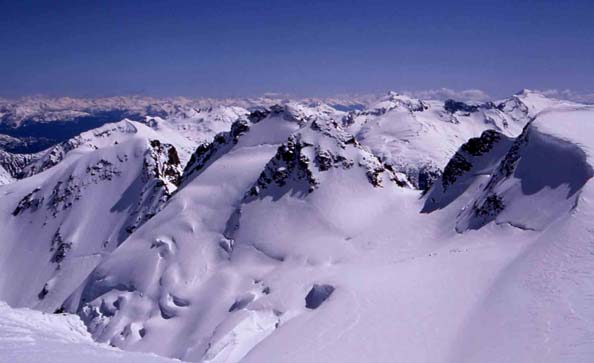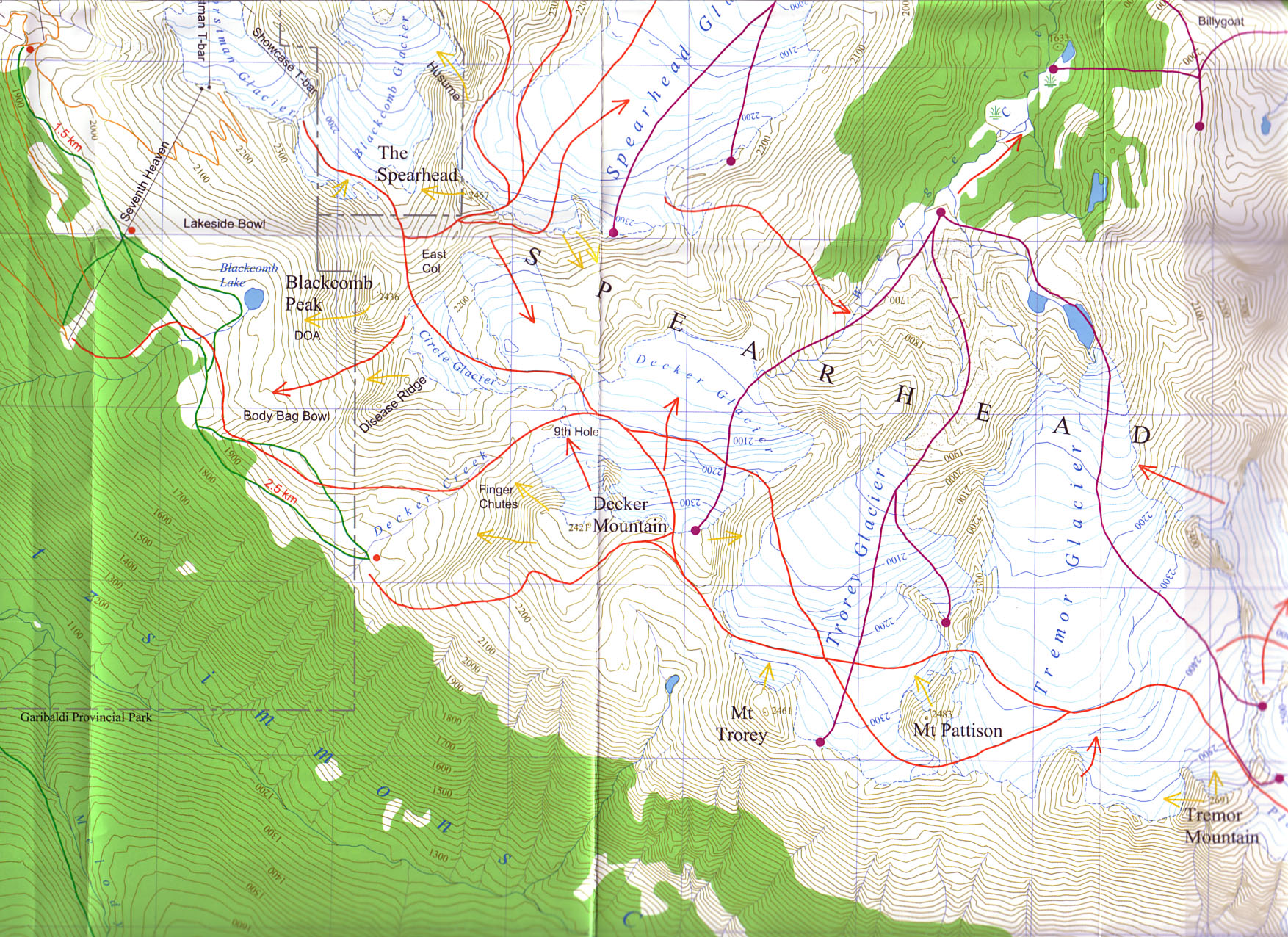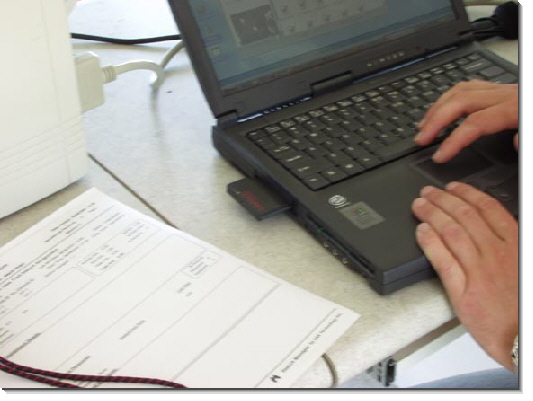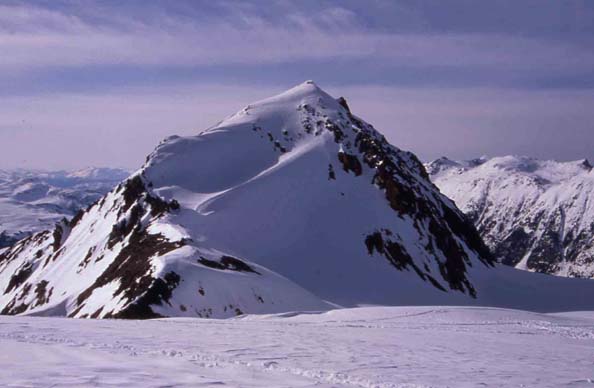

![]() 'Incident Commander
Pro - Version 8'
'Incident Commander
Pro - Version 8'
- Glacier
Response -
Glacier Rescue managed using 'Incident Commander Pro' Software
|
|
|
Skiers were rescued near the Platform Glacier on the Spearhead Traverse. Rescuer is at centre. |
Backcountry Skiers Rescued from Blizzard on Spearhead Glacier
Skiers trapped in Whistler's glacial wilderness for six days.
 Two
backcountry skiers from North Vancouver, B.C., had planned to ski
the Spearhead Traverse, a major alpine
tour that crosses 18 glaciers between Whistler and Blackcomb Mountains. They had
expected to complete the traverse in four days but low visibility and spring
storms trapped them on the mountains for nearly a week.
Two
backcountry skiers from North Vancouver, B.C., had planned to ski
the Spearhead Traverse, a major alpine
tour that crosses 18 glaciers between Whistler and Blackcomb Mountains. They had
expected to complete the traverse in four days but low visibility and spring
storms trapped them on the mountains for nearly a week.
 |
|
Spearhead Range, Looking East |
 After three days of touring the two skiers became disoriented in heavy cloud
on the glaciers and at one point were alarmed to find their ski tips hanging
over a void. They cautiously attempted to backtrack to their last know
position, m
After three days of touring the two skiers became disoriented in heavy cloud
on the glaciers and at one point were alarmed to find their ski tips hanging
over a void. They cautiously attempted to backtrack to their last know
position, m
By Tuesday evening when the pair
had not returned to Whistler family friends became worried.
"We negotiated for 18 hours
and finally made the call to Search and Rescue at 7 p.m. on Wednesday,"
said their girlfriend. "We spent all night waiting and
finally came up to Whistler to help."
 |
|
Ski Routes on the Spearhead Traverse |
 On Wednesday bad weather rolled into the mountains as a late spring storm
dumped heavy snow onto the mountains. Avalanche conditions and visibility were
so bad that mountain guides suspended all heli-skiing operations in the range.
On Wednesday bad weather rolled into the mountains as a late spring storm
dumped heavy snow onto the mountains. Avalanche conditions and visibility were
so bad that mountain guides suspended all heli-skiing operations in the range.
The skiers finished building
their camp just before the major storm hit. Huge quantities of snow began to
fall, followed by high winds, loading all of the mountain slopes to a dangerous
avalanche condition.
"The toughest part was finding a place to pitch our tent," "Once we were in the tent, it was like World War 2 because 150-km/h winds threatened to flatten us. We were worried of being buried alive, but as soon as the snow piled up, the wind would pick up and completely unbury us."
 At the
Command Post searchers prepared for a major
rescue mission. It was known that the pair had only enough food and fuel for
three to four days and by Thursday evening six days had already passed. Heavy
storms continued to pummel the mountains and only one brief helicopter sortie
was completed. There were still no signs of the missing skiers.
At the
Command Post searchers prepared for a major
rescue mission. It was known that the pair had only enough food and fuel for
three to four days and by Thursday evening six days had already passed. Heavy
storms continued to pummel the mountains and only one brief helicopter sortie
was completed. There were still no signs of the missing skiers.

On Thursday evening more alpine-skilled
responders were called in to assist with the
expanding mission.
 |
|
Creating Assignments using |
![]() SAR
Technology-Advanced Mission Support
SAR
Technology-Advanced Mission Support
A computer network running 'Incident Commander
Pro' was
installed at the Command Post to manage the incident.
![]() Mission briefings,
field assignments, digital maps of the glacial Spearhead Range, portraits of
the skiers, weather reports and GPS routes of the entire traverse, for
navigation in a whiteout, were all incorporated into the Optimized
Mission Plan.
Mission briefings,
field assignments, digital maps of the glacial Spearhead Range, portraits of
the skiers, weather reports and GPS routes of the entire traverse, for
navigation in a whiteout, were all incorporated into the Optimized
Mission Plan.
Avalanche control experts and
mountain guides from the Whistler ski resort offered their assistance in
assessing the avalanche conditions and preparing for an alpine style rescue
attempt should the weather clear.
![]() Meanwhile
high in the alpine the storm was raging. The embattled skiers began digging out
their buried equipment, rebuilding their camp and rationing their remaining food
and fuel. They ate just one meal of cold oatmeal for breakfast and only the cold
alpine air for ‘dinner’ in the evening.
Meanwhile
high in the alpine the storm was raging. The embattled skiers began digging out
their buried equipment, rebuilding their camp and rationing their remaining food
and fuel. They ate just one meal of cold oatmeal for breakfast and only the cold
alpine air for ‘dinner’ in the evening.
Outside their camp 50 to 60 centimetres
of snow fell within 24 hours, greatly increasing the risk of an
avalanche.
 |
|
Fissile Peak, Spearhead Range |
![]() "Wind slabs were created,
making the backcountry very susceptible to human-triggered avalanches,"
said a SAR spokesman. "The skiers were last
spotted on Platform Glacier on Sunday, which is a heavily glaciated area with
wide crevasses due to a low snow pack."
"Wind slabs were created,
making the backcountry very susceptible to human-triggered avalanches,"
said a SAR spokesman. "The skiers were last
spotted on Platform Glacier on Sunday, which is a heavily glaciated area with
wide crevasses due to a low snow pack."
 On Friday morning search teams attempted to fly over the Spearhead Traverse and
land at various locations, to assess the snow stability along the route.
Unfortunately heavy clouds obscured most of the higher mountains and passes and,
shortly after midday, all of the aerial searching was called off.
On Friday morning search teams attempted to fly over the Spearhead Traverse and
land at various locations, to assess the snow stability along the route.
Unfortunately heavy clouds obscured most of the higher mountains and passes and,
shortly after midday, all of the aerial searching was called off.
With the air searching halted
search teams were then assigned to ground deployments at lower elevations, to
examine the main exit routes out of the range, including the toe of the main
glaciers.
Late on Friday afternoon the
clouds parted briefly, permitting the helicopters to continue their searching.
With little remaining fuel one of the helicopters found a gap in the cloud and
began to search two high probability alpine passes. As they flew over the Tremor
/ Shudder Col they spotted two skiers below. Landing quickly they identified the
pair as the missing skiers and rapidly bundled them into the helicopter. Once
the area was clear a second helicopter landed and collected all of their
equipment. As the clouds rolled back over the mountains the helicopters
transported the skiers back to the Whistler town-site, to waiting friends and a
host of local media.
 |
| Rescued Backcountry Skiers |
"The hard part was the waiting in zero visibility and hearing the choppers overhead. We wanted to get out of there so bad, but we knew it was not the time to go anywhere," Finally when the clouds parted briefly and the helicopter landed. "I thought, 'Oh my God, it's blue sky and we are going home.'"
Despite their six day ordeal
neither skier suffered any significant injury, although both were thirsty and
hungry. Their wise decision to stay put in their shelter and wait out the bad
weather was a major factor in the eventual safe recovery.
For more information please contact:
![]() SAR
Technology Inc.
SAR
Technology Inc.
 Phone:
(604) 921-2488
Phone:
(604) 921-2488  Fax
(604) 921-2484
Fax
(604) 921-2484 ![]() sartechnology@telus.net
sartechnology@telus.net